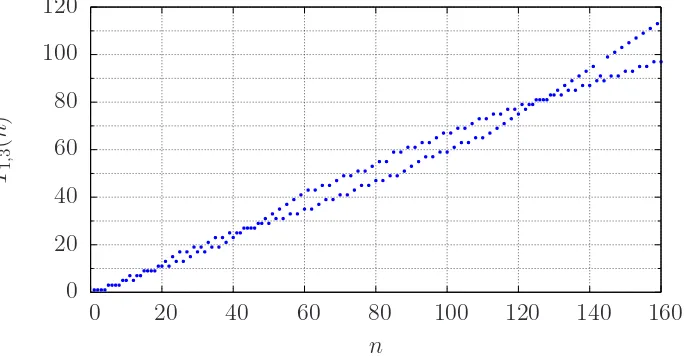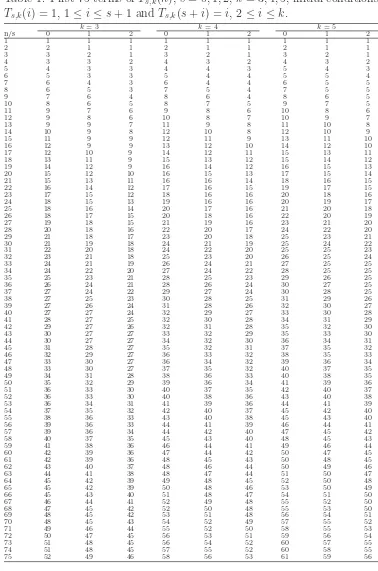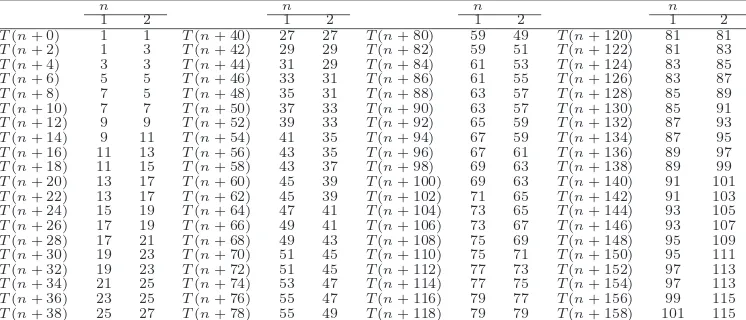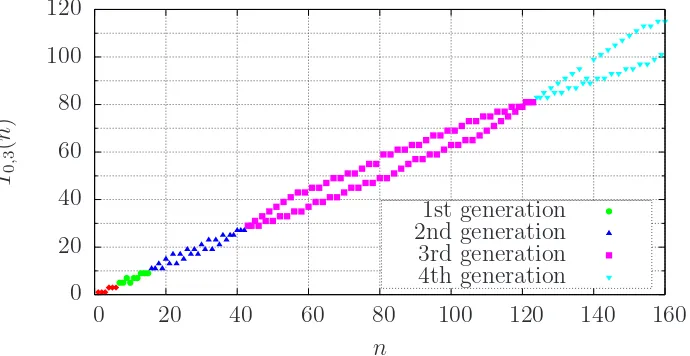23 11
Article 08.3.6
Journal of Integer Sequences, Vol. 11 (2008),
2 3 6 1 47
How the Shift Parameter Affects the Behavior of a
Family of Meta-Fibonacci Sequences
Mu Cai and Stephen M. Tanny
Department of Mathematics
University Of Toronto
Toronto, Ontario M5S 2E4
Canada
[email protected]
Abstract
We explore the effect of different values of the shift parameterson the behavior of the family of meta-Fibonacci sequences defined by thek-term recursion
Ts,k(n) := k−1
X
i=0
Ts,k(n−i−s−Ts,k(n−i−1)), n > s+k, k≥2
with the s+kinitial conditions Ts,k(n) = 1 for 1 ≤n≤s+k. We show that for any oddk≥3 and non-negative integersthe values in the sequenceTs,k(n) andT0,k(n) are essentially the same. The only differences in these sequences are that each power ofk
occurs preciselyk+stimes inTs,k(n) andktimes inT0,k(n). For evenkthe frequency of kr in T
0,k(n) depends upon r. We conjecture that fork even the effect of the shift parametersis analogous to that forkodd, in the sense that the only differences in the sequencesTs,k(n) and T0,k(n) occur in the frequencies of the powers ofk; specifically, each power of k appears to occur precisely s more times in Ts,k(n) than it does in
T0,k(n).
1
Introduction
In this paper, unless otherwise indicated all values are integers. Fors≥0 andk ≥2 consider the generalized Conolly meta-Fibonacci (self-referencing) recursion defined in [2]:
Ts,k(n) := k−1
X
i=0
For given values of the parameters s and k the behavior of the sequence defined by (1.1) is highly sensitive to the choice of the initial conditions. Some initial conditions lead to sequences with identifiable and regular (though potentially very complex) patterns, while others generate highly chaotic sequences or even cause the sequence Ts,k(n) eventually to
fail to be defined; that is, for some value of n the argument of one of the terms on the right hand side of Ts,k(n) becomes negative. See [2] for additional details.
In the special case s= 1, and with the initial conditionsT1,k(1) := 1 andT1,k(i) :=i−1,
2 ≤ i ≤ k + 1, the resulting sequence behaves in a very simple manner [7]. In particular, it is monotone and its consecutive terms increase by either 0 or 1, so it hits every positive integer. Following Ruskey [9] we term such a sequence “slowly growing”.
In [5] and [6] Ruskey and his colleagues derive a beautiful combinatorial interpretation in terms of k-ary trees for each of the sequences generated by (1.1) with k ≥ 2, s ≥ 0 and the initial conditions Ts,k(i) := 1 for 1 ≤ i ≤ s+ 1 and Ts,k(s+i) := i, 2≤ i ≤ k. Using
these initial conditions, which are a natural analogue for general s to the ones in [7] for
s= 1, they show that for every k ≥2 all these sequences are slowly growing. Even further, from their combinatorial interpretation it is immediate that for fixedk the sequencesTs,k(n)
and Ts+1,k(n) are essentially the same: the only differences in these sequences occur in the
frequencies with which the powers ofk occur. In particular, each power ofkoccurs precisely one more time in the sequence Ts+1,k(n) than it does inTs,k(n). See Table1 for examples of
this for k = 3,4,5 and s = 0,1,2.
The shift parameter is known to have this benign type of effect on other families of slowing growing sequences that are generated by a meta-Fibonacci recursion similar to the one for
Ts,k(n). See, for example, [1]. The focus of this paper is to show that the shift parameter s
can have such a modest effect even when the behavior of the sequence is considerably more complicated.
We demonstrate this by showing it to be the case for the family of sequences generated by (1.1) but this time with a very different set of initial conditions, namely, Ts,k(n) = 1 for
1 ≤ n ≤ s+k. These sequences are introduced in [2], but only the special case s = 0 is analyzed in detail. They are not monotone and display considerably more complex behavior than that of the slowly growing sequences discussed in [5] and [6]. See Figures1,2and3. In [2] the structure of these sequences is completely described fors = 0 andkodd. In particular it is shown that the terms of the sequence T0,k(n) that are equal to kr for any non-negative
integer r necessarily appear as a block of k consecutive terms. Table 2 illustrates this for
k = 3 ands= 0; note the three consecutive occurrences of the values 3, 9, 27 and 81. In this paper we extend the analysis in [2] by allowing arbitrary positive integer values fors. Specifically we prove that for any oddk ≥3 and any non-negative integers the values in the sequence Ts,k(n) and T0,k(n) are essentially the same. The only differences in these
sequences are that each power of k occurs precisely k +s times in Ts,k(n) and k times in
0 20 40 60 80 100 120
0 20 40 60 80 100 120 140 160
T0
,
3
(
n
)
n
Figure 1: First 160 terms of T0,3(n) with initial values (1,1,1)
0 20 40 60 80 100 120
0 20 40 60 80 100 120 140 160
T1
,
3
(
n
)
n
0 20 40 60 80 100 120
0 20 40 60 80 100 120 140 160
T2
,
3
(
n
)
n
Figure 3: First 160 terms ofT2,3(n) with initial values (1,1,1,1,1)
The proof of this simply stated and intuitively intriguing result is highly technical and makes extensive use of the approaches and results in [2]. It relies upon a series of nested induction arguments that are essentially the same for any oddk. As such, we proceed slowly and in stages, initially providing the details for the special case k= 3, where they are easier to follow. In Section 2 we establish the base cases= 1, namely, the result holds for the pair of sequences T0,3(n) and T1,3(n). We complete the induction for the case k = 3 and general
s in Section 3. In Section 4 we sketch the induction argument for general odd k.
In Section 5 we conclude with some brief observations about the situation for k even. Based upon substantial empirical evidence it appears that our result also holds for this case. However, unlike the situation fork odd, there is no starting point for an induction argument similar to the one we use below since to date nothing has been proved about the sequences
2
The behavior of
T
1,3(
n
)
Consider the recursion (1.1) with k = 3 and s = 0 with initial conditions T(1) = T(2) =
T(3) = 1:
T(n) =T(n−T(n−1)) +T(n−1−T(n−2)) +T(n−2−T(n−3)) (2.1)
For convenience throughout this paper we omit either or both of the subscripts s and
k where this causes no confusion. Following [2] we define U(n) = T(n − T(n −1)), so
T(n) =U(n) +U(n−1) +U(n−2). We determine bounds on U(n).
As in Definition 3.5 in [2], for anyg >0 call the interval (of the domain of the sequence) [mg, mg+1 −1] the gth generation of the sequence T(n), written as gen(g), where mg =
1 2(3
g+1
+ 5). See Figure4. Notice that the value ofT(n) at the endpoints of each generation are powers of 3.
Figure 4: Initial portion of generation structure of T0,3(n)
U(mg+1−1)≥U(mg+1−3)≥U(mg+1−5) =U(mg+1−2)≥U(mg+1−4) = U(mg+1−1).
So U(mg+1−1) = U(mg+1−2) =U(mg+1−3) = 1
3T(mg+1−1) = 3
g. This completes the
proof of the second part of the statement of the lemma. It remains to prove that forn ∈[mg, mg+1−1], 3g−
n), and that each of these subsequences for generation g begins with at least 3g−1 and ends
no higher than 3g. This concludes the proof.
Now consider the recursion (1.1) with k = 3 ands= 1 (“shift parameter 1”), namely,
T1(n) = T1(n−1−T1(n−1)) +T1(n−2−T1(n−2)) +T1(n−3−T1(n−3)). (2.2)
LetU1(n) =T1(n−1−T1(n−1)), so T1(n) =U1(n) +U1(n−1) +U1(n−2). (Note that our
notation suppresses the parameter k = 3.) Four initial conditions are required, and these are T1(1) =T1(2) =T1(3) =T1(4) = 1. For 2 ≤g, we define the (g−1)th generation of the
“shifted” sequence T1(n) as the interval n ∈[mg−1+g, mg+g]. For brevity we sometimes
refer to this interval as the “shifted” (g−1)th generation. The main result is the following:
Theorem 2.2. Let 2≤g. For n ∈[mg−1+g, mg+g], the shifted (g−1)th generation, the
Note that the second part of (2) follows from (1); we include it for convenience as we’ll use it directly below. From (1) it follows that the sequenceT1(n) hits powers of 3 exactly 4
times at the end of each generation (recall that the sequenceT0(n) hits powers of 3 exactly
3 times at the end of each generation). From (2) we have that otherwise the sequences are the same, since for r ∈ [mg−1, mg −1], T0(r) = T1(r+g) (since if r ∈ [mg−1, mg −1], then
r+g ∈[mg−1+g, mg+g−1]. Thus we have that the sequences are identical except for the
frequency of the occurrences of the powers of 3. Compare Tables2 and 3 for an illustration of this.
Proof. Here we require a nested induction, on both g and n. We begin with the induction ong, the “outer induction”. For g = 2 we check each of the statements numerically for the shifted first generation. We begin with (1). Here n ∈[mg−1+g, mg+g−4] = [(
completes the proof of (1). In a similar way we confirm that (2) holds. Thus the base case is done.
Suppose both (1) and (2) hold for the 1st,2nd, . . . ,(g−2)thshifted generations withg ≥3.
generation, which is the intervaln∈[mg−1+g, mg+g]. Once again we proceed by induction,
this time onn; this is what we call the “inner induction”.
We begin by confirming that (1) and (2) hold for the initial value of this interval, namely
n = mg−1 +g. Specifically, we need to confirm that for this value of n, T1(n) ∈ (3g−
holds for the (g−2)thshifted generation. Thus,T
1(n−1) = 3g−1, whileU1(n−1) =U1(n−2) =
U1(n−3) = 3g−2. Also, U1(n) =T1(n−1−T1(n−1)) =T1(mg−1+g−1−3g−1) =T1(mg−2+
g−1). Note thatmg−2+g−1 is the first member of the (g−2)thshifted generation (so it’s not
among the last four terms of the generation). It follows by the induction assumption ong that
U1(n) = T1(mg−2+g−1)∈(3g−2,3g−1). SoT1(n) =U1(n)+U1(n−1)+U1(n−2)∈(3g−1,3g)
induction assumption on g for (2) for the (g − 2)th shifted generation we have U
1(n) =
is true for any number in this generation smaller than n, i.e. we suppose for any i ∈ [mg−1+g, n−1] = I(g;n−1), the following two statements hold:
8. By Tables 2 and 3 we confirm that T1(6) = T0(4), T1(7) = T0(5), T1(8) = T0(6). Thus
shifted). By [2] and Lemma 2.1 we know exactly the range of these values, so (1) follows immediately. Finally, the value of T1(mg +g) is readily computed as follows: by definition
T1(mg +g) = U1(mg+g) +U1(mg+g−1) +U1(mg+g−2) = 3g. By Theorem 4.3 in [2]
(g−1)th shifted generation, as required. This completes the outer induction ong and hence
the proof of Theorem 2.2.
3
The behavior of
T
s,3(
n
)
for
s
≥
1
Now we consider the behavior of the sequence generated by (1.1) withk = 3, shift parameter
s ≥ 1 and initial conditions Ts(1) = Ts(2) = Ts(3) = ... = Ts(s + 3) = 1. Let Us(n) =
Ts(n−s−Ts(n−1)), soTs(n) =Us(n) +Us(n−1) +Us(n−2). (Note that here our notation
omits the subscriptk = 3). Our goal is to generalize Theorem2.2 as follows:
Proof. Observe that for s= 1 we know that (1) holds for (1, g) for allg by Theorem2.2, as does (2) for the triple (s−1, s, g) = (0,1, g) for all g.
For an arbitrary positive integer sgreater than 1, we proceed by induction ons. By this we mean that for allg we assume that (1) holds for all thes pairs (0, g),(1, g), . . . ,(s−1, g) and that (2) holds for thes−1 triples (0,1, g),(1,2, g), . . . ,(s−2, s−1, g). Our immediately preceding observation establishes the base case for the induction argument.
We need to show that (1) holds for the pair (s, g) and (2) holds for the triple (s−1, s, g). To do this we imitate the proof of Theorem 2.2, once again applying a double induction on bothg and n (so overall a triple induction!). We begin with the so called “outer induction” ong.
We first establish the base case for g = 2. From the initial conditions Ts(1) = Ts(2) =
Ts(3) = ... = Ts(s+ 3) = 1 we have, by direct substitution, Ts(s+ 4) = Ts(s+ 5) = ... =
Ts(2s+ 6) = 3. Further direct computation yields that for n ∈ [mg−1+gs, mg +gs−4] =
[7 + 2s,12 + 2s] we have Ts(n)∈(3,9) and Us(n), Us(n−1), Us(n−2)∈[1,3]. And similar
computation shows that forn∈[mg+gs−3, mg+ (g+ 1)s−1] = [13 + 2s,15 + 3s],Ts(n) = 9
and Us(n) =Us(n−1) =Us(n−2) = 3. This confirms (1).
In a similar way we compute the values ofTs−1(n−g). Combining these with the values of
Ts(n), we find that (2) is immediate. This concludes the base case for the “outer induction”,
that is, (1) holds for the pair (s,1) and (2) holds for the triple (s−1, s,1).
The induction assumption is that (1) holds for the pairs (s,1),(s,2), . . . ,(s, g−2) and (2) holds for the triples (s−1, s,1),(s−1, s,2), . . . ,(s−1, s, g−2). We want to show that (1) holds for the pair (s, g−1) and (2) holds for the triple (s−1, s, g−1).
We proceed by an “inner induction” onnwithin the (g−1)thshifted generation, which is
the intervaln∈[mg−1+gs, mg+ (g+ 1)s−1]. First we check the initial valuen=mg−1+gs.
Specifically, we confirm that for this value ofn,Ts(n)∈(3g−1,3g),Us(n), Us(n−1), Us(n−2)∈
[3g−2
,3g−1
], and further Ts(n) =Ts−1(n−g).
Sincen =mg−1+gsis the first term of the (g−1)thshifted generation,n−1 =mg−1+gs−1
is the last term of the (g −2)th shifted generation. By the induction assumption on g, (1)
holds for (s, g−2). ThusTs(n−1) = 3g−1, while Us(n−1) =Us(n−2) =Us(n−3) = 3g−2.
SoUs(n) =Ts(n−s−Ts(n−1)) = Ts(mg−1+gs−s−3g−1) =Ts(mg−2+ (g−1)s). Note
that mg−2+ (g−1)s is the first member of the (g−2)th shifted generation. Since there are
more than s+ 3 terms in the generation and only the last s+ 3 terms are powers of 3 it follows by the induction assumption ong thatUs(n) = Ts(mg−2+ (g−1)s)∈(3g−2,3g−1). So
Ts(n) =Us(n)+Us(n−1)+Us(n−2)∈(3g−1,3g) andUs(n), Us(n−1), Us(n−2)∈[3g−2,3g−1].
This confirms (1).
We prove (2) similarly. By the above argument Us(n) =Ts(mg−2+ (g−1)s), so by the
induction assumption on g that (2) holds for (s−1, s, g−2) we have Us(n) = Ts(mg−2 +
(g−1)s) = Ts−1(mg−2+ (g−1)(s−1)). Since n =mg−1+gs, we have Ts−1(n−g −1) =
Ts−1(mg−1 +g(s − 1)− 1) = 3g−1 by the induction assumption on s that (1) holds for
(s−1, g−2). SoUs−1(n−g) = Ts−1(n−g−s−Ts−1(n−g−1)) =Ts−1(mg−1+g(s−1)−(s−
1)−Ts−1(mg−1+gs−g−1)) =Ts−1(mg−1−3g−1+(g−1)(s−1)) =Ts−1(mg−2+(g−1)(s−1)).
Thus we getUs(n) = Ts−1(mg−2+ (g−1)(s−1)) =Us−1(n−g).
Note thatn−g−1 =mg−1+g(s−1)−1 is the last term of the (g−2)th shifted generation
g−2) = Us−1(n−g−3) = 3g−
theorem is true for any number in this generation smaller than n, i.e. we suppose for any
i∈[mg−1+gs, n−1] =I(s, g;n−1), the following two statements hold:
that this interval consists of the last three members of the (g −3)th shifted generation for
parameters−1 together with all of the (g−2)th shifted generation for parameters−1. By
the induction assumption ong it follows that (2) holds for (s−1, s, g−3) and (s−1, s, g−2) so it holds on this interval. Now let r =n−g−(s−1)−Ts−1(n−g −1) which is in this
interval. Then we haveTs−1(r) =Ts(r+g−1).
But by the induction assumption on the parameter n that (2) holds for n−1 we have
Ts(n−1) = Ts−1(n−g−1). ThusTs(r+g−1) =Ts(n−g−(s−1)−Ts−1(n−g−1)+g−1) =
shifted (g−1)th generation for parameters.
To prove (1) first notice that the value of Ts(n) is just the value of Ts−1(n−g), and the
values of Us(n), Us(n−1), Us(n−2) are just the values ofUs−1(n−g), Us−1(n−g−1) and
Us−1(n−g−2), wheren−g ∈[mg−1+g(s−1) + 1, mg+ (g+ 1)(s−1)−1] is in the (g−1)th
shifted generation for parameters−1. By the induction assumption on s we know exactly the range of these values, so (1) follows immediately.
Finally, we compute the value of Ts(mg+ (g+ 1)s−1) as follows: by definition Ts(mg+
(g+ 1)s−1) =Us(mg+ (g+ 1)s−1) +Us(mg+ (g+ 1)s−2) +Us(mg+ (g+ 1)s−3) = 3g. By
the induction assumption ons,Ts−1(mg+ (g+ 1)(s−1)−1) =Ts−1(mg+ (g+ 1)(s−1)−2) =
Ts−1(mg+(g+1)(s−1)−3) = 3g. So by the induction assumption ongand direct substitution
we haveUs(mg+(g+1)s−1) =Ts(mg+(g+1)s−1−s−Ts(mg+(g+1)s−2)) =Ts(mg+(g+
1)s−1−s−Ts−1(mg+ (g+ 1)(s−1)−1)) =Ts(mg+gs−1−3g) = Ts(mg−1−1 +gs) = 3g−1.
Recall above we’ve shown thatUs(mg+ (g+ 1)s−2) =Us(mg+ (g + 1)s−3) = 3g−1 since
mg+(g+1)s−2 is in the (g−1)thshifted generation and is not the last term. Summing these
we obtainTs(mg+(g+1)s−1) = 3g =Ts−1(mg+(g+1)(s−1)−1) =Ts−1(mg+(g+1)s−1−
(g+1)). Thus both (1) and (2) are confirmed forTs(mg+(g+1)s−1). This finishes the proof
of both (1)and (2) fori=n. Thus the theorem is true forn∈[mg−1+gs, mg+ (g+ 1)s−1],
the (g−1)th shifted generation, thereby completing the “inner induction” on n.
This completes the “outer induction” on g and hence the induction on s.
4
The behavior of
T
s,k(
n
)
for
s
≥
1
and odd
k
The arguments in Section 2 and Section 3 for the case k = 3 rely on several key results from [2], analogues of which hold for any odd k. It follows that we can generalize all of the preceding, in particular Lemma2.1 and Theorem3.1, in a natural way. Because the proofs would be entirely analogous to (but even more tedious than) the ones given above we limit ourselves to a statement of these extensions.
Consider the recursion (1.1) with s≥0, oddk≥3, and the initial conditions Ts,k(n) = 1
for 1≤n≤s+k. DefineUs,k(n) = Ts,k(n−s−Ts,k(n−1)). Once again, as in Definition 5.7
in [2], for any g >0 call the interval (of the domain of the sequence) [mg, mg+1−1] the gth
generation of the sequence Ts,k(n), written as gen(g), where mg = k−11(k
g+1
+k2
−k−1).
Lemma 4.1. Let 2 ≤ g, and suppose that n is in the (g−1)th generation. Then kg−2
≤
Us,k(n), Us,k(n − 1), . . . , Us,k(n − k + 1) ≤ kg−1. Moreover, if n is the last term of the
generation, then Us,k(n) = Us,k(n−1) =· · ·=Us,k(n−k+ 1) =kg−1.
Theorem 4.2. Let s ≥ 1 and 2 ≤ g. For n ∈ [mg−1 +gs, mg+ (g + 1)s−1], the shifted
(g−1)th generation, the following two statements hold:
(1) If n is one of the last k+s terms of the generation, then Ts,k(n) =kg and Us,k(n) =
Us,k(n−1) = · · ·=Us,k(n−k+ 1) =kg−1. If n is any other member of the generation, then
kg−1
< Ts,k(n)< kg and kg−2 ≤Us,k(n), Us,k(n−1), . . . , Us,k(n−k+ 1) ≤kg−1.
(2) If n is the last term of the generation, Ts,k(n) =Ts−1,k(n−g−1). If n is any other
5
Conjectures for even
k
For even k the effect of the shift parameter s on the behavior of the sequences generated by (1.1) with the initial conditions Ts,k(n) = 1 for 1 ≤ n ≤ s+k appears to be quite
similar. We conjecture that the sequencesTs,k(n) and T0,k(n) are essentially the same, with
the only differences in these sequences occurring in the frequencies with which the powers of k occur. In particular, in the sequence Ts,k(n) we conjecture that each value kr occurs
precisely s+k+ (r−1) times. See Tables 5, 6, and 7for an example of this for k = 4 and
s= 0, 1 and 2.
Observe that if the conjectures relating to even k in [2] hold then it should be possible to prove our present conjectures by following an approach analogous to the one adopted above.
6
Acknowledgements
The authors are grateful to Wendy Wu for her substantial assistance in the preparation of this manuscript.
References
[1] B. Balmohan, Z. Li and S. Tanny, A combinatorial interpretation for certain relatives of the Conolly sequence, J. Integer Sequences, 11 (2008), Article 08.2.1.
[2] J. Callaghan, J. J. Chew and S. M. Tanny, On the behavior of a family of meta-Fibonacci sequences, SIAM J. Discrete Math. 18 (2005), 794–824.
[3] B. W. Conolly, Meta-Fibonacci sequences, in S. Vajda, ed.,Fibonacci & Lucas Numbers, and the Golden Section, Wiley, 1986, pp. 127–137.
[4] B. Dalton and S. M. Tanny, Generational structure of meta-Fibonacci sequences, unpub-lished manuscript, 2005.
[5] C. Deugau and F. Ruskey, Complete k-ary trees and generalized meta-Fibonacci se-quences, in Fourth Colloquium on Mathematics and Computer Science: Algorithms, Trees, Combinatorics and Probabilities, DMTCS Proceedings Series, 2006 AG, pp. 203– 214.
[6] B. Jackson and F. Ruskey,Meta-Fibonacci sequences, binary trees and extremal compact codes, Electronic J. Combinatorics 13 (2006), #R26.
[7] J. Higham and S. M. Tanny, More well-behaved meta-Fibonacci sequences, Congressus Numerantium 98 (1993), 3–17.
[8] J. Higham and S. M. Tanny, A tamely chaotic meta-Fibonacci sequence, Congressus Numerantium 99 (1994), 67–94.
[10] N. J. A. Sloane, Online Encyclopedia of Integer Sequences, http://www.research.att.com/∼njas/sequences.
[11] S. M. Tanny, A well-behaved cousin of the Hofstadter sequence, Discrete Math. 105 (1992), 227–239.
2000 Mathematics Subject Classification: Primary 11B37; Secondary 11B39, 11B99.
Keywords: Hofstadter, iterated recursion, meta-Fibonacci, Q sequence.
Received June 2 2008; revised version received August 15 2008. Published in Journal of Integer Sequences, August 17 2008.





